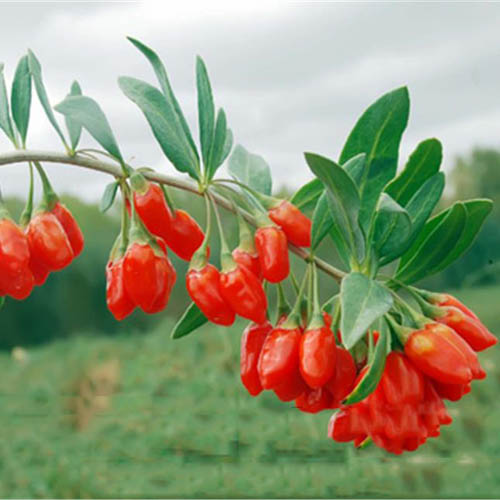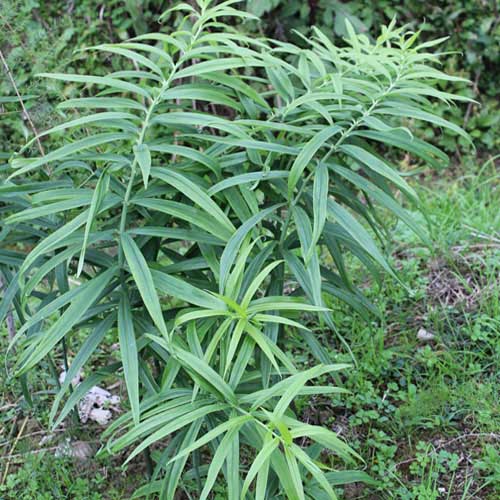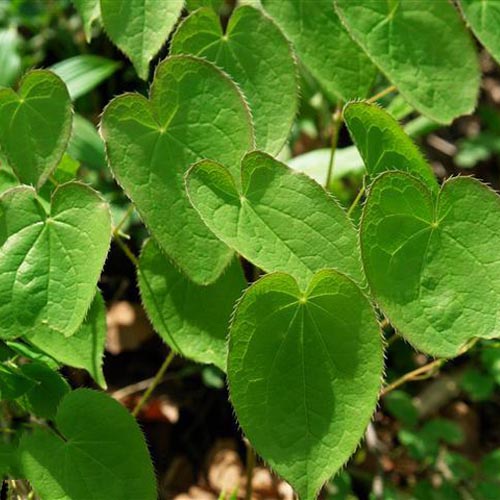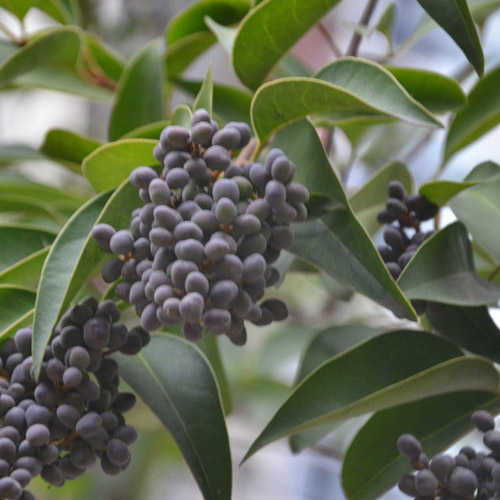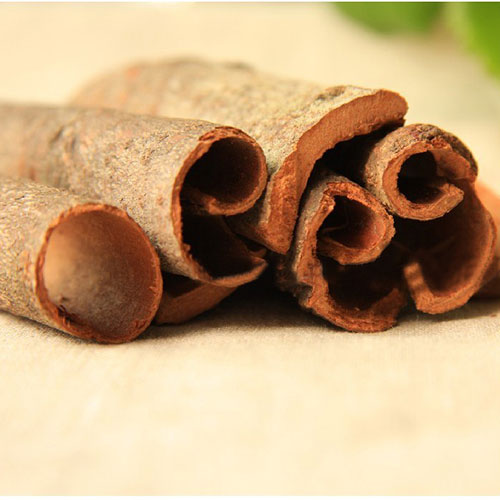- Chinese Name Gou Qi 枸杞
- Latin Name Lycium barbarum L
- Other Names Gou Qi Zi, Goji Berry, Fructus Lycii, Chinese Wolfberry Fruit, Matrimony Vine Fruit
- Used Part Fruit
- Specification Powdered Extract; Juice Powder
Lycium Fruit Extract Powder
Description
Goji berries have long been considered an anti-aging food in Asia and have been an important part of traditional Chinese herbalism for nearly 2,000 years, and modern studies substantiate its health benefits.
The Goji berry contains over 15% protein, 21 essential minerals, 18 amino acids, and one of the highest amounts of beta carotene. The Goji fruit contains many other key nutrients such as vitamin C, vitamins B1 and B2, beta-sitosterol, linoleic acid (a fatty acid) and immunologically active polysaccharides (5-8%) which have extremely high immune supporting properties. This nutrient-dense super food is in a class all its own.
Antioxidants
Antioxidants help to protect our DNA from damage by free radicals and radiation. Without an ample supply of antioxidants our body becomes open to illness and accelerated aging. Free radicals are generated as a byproduct of normal metabolism and exposure to toxins and radiation. This eventually results in an early cell death which has been contributed to a variety of diseases and to the accelerated development of mutated cells that may lead to cancer. All of this is countered with the help of antioxidants.
Carotenoids
Goji berries are one of the best sources of the carotenoid antioxidants, even more than carrots. This is important since research has indicated that the carotenoid content of human tissue is a statistically significant factor in determining our maximum lifespan potential. This means the more carotenoids we consume, the better the possibility we may live a longer life.
Eye Health
Goji berries also contains some very important nutrients for eye health. These include zeaxanthin and lutein. A diet with increased levels of zeaxanthin and lutein has been helpful in decreasing the risk of developing age related macular degeneration, the leading cause of blindness and loss of vision in people above the age of 65.
Immunity & Longevity
Goji berries have also been found to boost the immune system. There are three main components in the goji berry that do this: polysaccharides, beta-carotene, and germanium. Polysaccharides are well known for their immune boosting properties, while beta-carotene seems to boost interferon`s stimulation on the immune system. Germanium, which has been found to be effective in treating certain types of cancer, is also critical in boosting interferon levels. Goji berries also contain sesquiterpenoids which have anti-inflammatory properties. The sesquiterpenoids contained in goji berries are found to be a powerful secretagogue. A secretagogue stimulates the secretion of the human growth hormone by the pituitary gland.
Due to the vitamin and mineral content of goji berries, and the fact that they are the only known food sourced with secretagogue, goji berries have long been known as a longevity food. In fact, legend has it that a man named Li Qing Yuen was believed to have lived to the age of 252 years.
TCM Tradition
Taste & Property Sweet, Neutral
Organ Meridians Liver, Lung, Kidney
TCM Functions
• Nourishes and tonifies Liver and Kidney Blood and Yin
– Blood and Yin Deficiency with sore back and legs, low-grade abdominal pain, impotence, nocturnal emissions, wasting and thirsting disorder and consumption
– Liver and Kidney Deficiency
• Benefits Jing and brightens the eyes
– Liver and Kidney Deficiency where Jing and Blood cannot nourish eyes with dizziness, blurred vision and diminished visual acuity
• Nourishes Yin and moistens the Lungs
– Consumptive cough and wasting and thirsting disorder
Science Research
Chemical Constituents
Major components in wolfberry includes Lycium barbarum glycoconjugates such as LbGp1, LbGp2, LbGp3, LbGp4 & PbGp5; Lycium barbarum polysaccharides such as LBP1a-1, LBP1a-2, LBP2a, LBP3a-1, LBP3a-2, LBPA3, LBPB1, LBPC2 & LBPC4; alkaloids such as betaine; carotenoids such as zeaxanthin, cryptosxanthin, and zeaxanthin dipalmitate; volatile compounds such as hexadecanoic acid, linoleic acid, β-sitosterol and myristic aicd. It also contains amino acids, trace elements, vitamins B & C, lyciumide A and scopoletin.
Pharmacological Actions
1. Effects on immunity
In vitro and animal studies
Many studies have shown that a polysaccharide-protein (LBP) complex isolated from Lycium barbarum (LBP) can enhance the immunity through: induce functional maturation of Dendritic cells, activate macrophages, stimulate proliferation of T cells, and induce IL-2, IL-12p40, IFN-gamma and IL-12p70 production. Furthermore, LBP can significantly enhance macrophage endocytic and phagocytic capacities in vivo.[1][2][3]
2. Anti-oxidant effect
In vitro study
Polysaccharides were extracted from Lycium barbarum with boiling water, and the antioxidant activities of different polysaccharide fractions were evaluated. Most fractions were effective in scavenging DPPH and ABTS.+ free radicals, superoxide anion and hydroxyl radical at 1000 μg/mL.[4]
3. Anti-stress effect
Animal study
After a 30-day exhaustive exercise program, researchers determined the lipid peroxidation, glycogen level, and anti-oxidant enzyme activities in the skeletal muscle of male Wistar rats. Results showed that Lycium barbarum polysaccharides can significantly increase glycogen level and anti-oxidant enzyme activity, and decrease malondialdehyde (MDA) level and creatine kinase activity. These indicate that Lycium barbarum polysaccharides administration can decrease the oxidative stress induced by the exhaustive exercise.[5]
4. Neuro-protective effect
In vitro study
Study has been done to determine whether Lycium barbarum polysaccharide (LBP) can elicit neuroprotection to neurons stressed by A-beta peptides. The results showed that pre-treatment of LBP to cultured neurons can effectively prevent A-beta peptide-induced apoptosis. Moreover, LBP-III, which was separated out from LBP, can markedly reduce the phosphorylation of double-stranded RNA-dependent protein kinase (PKR) triggered by A-beta peptide.[6]
5. Anti-tumor effects
Clinical study
Seventy nine advanced cancer patients were treated with LAK/IL-2 as well as Lycium barbarum polysaccharides (LBP). 75 patients with malignant melanoma, renal cell carcinoma, colorectal carcinoma, lung cancer, nasopharyngeal carcinoma or malignant hydrothorax have shown a sign of cancer regression. This treatment had also led to a higher increase of cell activities in NK and LAK than that of LAK/IL-2 only. The results indicate that LBP can be used as an adjuvant in the biotherapy of cancer.[7]
6. Effects on liver
In vitro study
In order to determine the effects of zeaxanthin dipalmitate (constituents of Lycium chinense) on liver cells, the uptake of [3H]thymidine by cultured rat Ito cells was measured. Moreover, the effects of zeaxanthin dipalmitate on the formation of nitric oxide (NO) from Kupffer cells and peritoneal macrophages were also assayed. The results show that zeaxanthin dipalmitate can significantly inhibit the uptake of [3H]thymidine and collagen synthesis by Ito cells, and the formation of NO in both Kupffer cells and peritoneal macrophages are also significantly decreased. From these results, we can conclude that zeaxanthin dipalmitate exerts a potent hepatoprotective activity by inhibiting Ito cell proliferation and collagen synthesis as well as inhibiting certain functions of Kupffer cells.[8]
7. Effects on eyes
Animal study
Using an ocular hypertension (OH) model in rat, researchers attempted to find out whether Lycium barbarum can prevent cell death of retinal ganglion cells (RGCs) induced by elevated intraocular pressure. Although the intraocular pressure was not significantly changed, ingestion of Lycium barbarum in Sprague-Dawley rats can significantly prevent the loss of RGCs.[9]
8. Effects on male-fertility
In vitro study
Lycium barbarum polysaccharides (LBP) possess the ability to inhibit time- or hyperthermia-induced structural damages in murine seminiferous epithelium, and delay the apoptosis of them. LBP can also inhibit the ultraviolet light-induced lipid peroxidation, and cytochrome c reduction and thus provides anti-oxidative effects to seminiferous epithelium.[10]
9. Effects on glycemia level and hyperlipidemia
Animal study
The hypoglycemic and hypolipidemic effects of Lycium barbarum water decoction, crude polysaccharide extracts, and purified polysaccharide fractions in diabetic or hyperlipidemic rabbits were determined. The blood glucose and serum lipid levels were measured after 10 days treatment. The results show that the three Lycium barbarum fruit extracts can significantly reduce the blood glucose, serum total cholesterol and triglyceride concentrations, at the same time increase the high density lipoprotein cholesterol levels.[11]
10. Effect on blood pressure
Animal study
The effects of Lycium barbarum polysaccharide (LBP) on endothelial function in the two-kidney, one clip model of hypertension rats were observed. The results show that by treating with LBP, the increase of blood pressure in hypertension rats can be inhibited significantly. The results also suggest that the decrease of vasoconstriction to phenylephrine may be mediated by increasing the effects and production of endothelium-derived relaxation factor.[12]
Toxicology
Many animal studies had proved that wolfberry is safe to eat; it does not contain any toxins and can consume in long-term. [13] However, there is a report mentioned the potential herbal-drug interaction between warfarin and wolfberry.[14]
Reference
1. Chen Z, et al. Polysaccharide-protein complex from Lycium barbarum L. is a novel stimulus of dendritic cell immunogenicity. J Immuno, 2009 Mar 15; 182(6): 3503-3509.
2. Chen Z, et al. Activation of macrophages by polysaccharide-protein complex from Lycium barbarum L.. Phytother Res, 2009 Aug; 23(8): 1116-1122.
3. Chen Z, et al. Activation of T lymphocytes by polysaccharide-protein complex from Lycium barbarum L.. International Immunopharmacology ; 8: 1663-1671.
4. Lin CL, et al. Antioxidative activity of polysaccharide fractions isolated from Lycium barbarum Linnaeus. Int J Biol Macromol, 2009 Aug 1; 45(2): 146-151.
5. Niu AJ, et al. Protective effect of Lycium barbarum polysaccharides on oxidative damage in skeletal muscle of exhaustive exercise rats. International journal of biological macromolecules; 42(5): 447-449..
6. Yu MS, et al. Characterization of the effects of anti-aging medicine Fructus lycii on beta-amyloid peptide neurotoxicity. International Journal of Molecular Medicine; 20(2): 261-268.
7. Cao GW, et al. Observation of the effects of LAK/IL-2 therapy combining with Lycium barbarum polysaccharides in the treatment of 75 cancer patients. Zhonghua Zhong Liu Za Zhi; 16: 428-431.
8. Kim HP, et al. Zeaxanthin dipalmitate from Lycium chinense has hepatoprotective activity. Res Commun Mol Pathol Pharmacol, 1997 Sep; 97(3): 301-314.
9. Chan HC, et al. Neuroprotective effects of Lycium barbarum Lynn on protecting retinal ganglion cells in an ocular hypertension model of glaucoma. Experimental Neurology; 203(1): 269-273.
10. Wang Y, et al. Protective effect of Fructus Lycii polysaccharides against time and hyperthermia-induced damage in cultured seminiferous epithelium. Journal of Ethnopharmacology; 82(2-3): 169-175.
11. Luo Q, et al. Hypoglycemic and hypolipidemic effects and antioxidant activity of fruit extracts from Lycium barbarum. Life Sci; 76: 137-149.
12. Jia YX, et al. The effect of Lycium barbarum polysaccharide on vascular tension in two-kidney, one clip model of hypertension. Sheng Li Xue Bao; 50(3): 309-314.
13. 華夏中醫藥網. 枸杞的功效和用法. Retrieved from the World Wide Web: http://data.zyy123.com/Fruit/Wolfberry/55157.html
14. Leung H, et al. Warfarin overdose due to the possible effects of Lycium barbarum L. Food Chem Toxicol; 46(5): 1860-1862.

